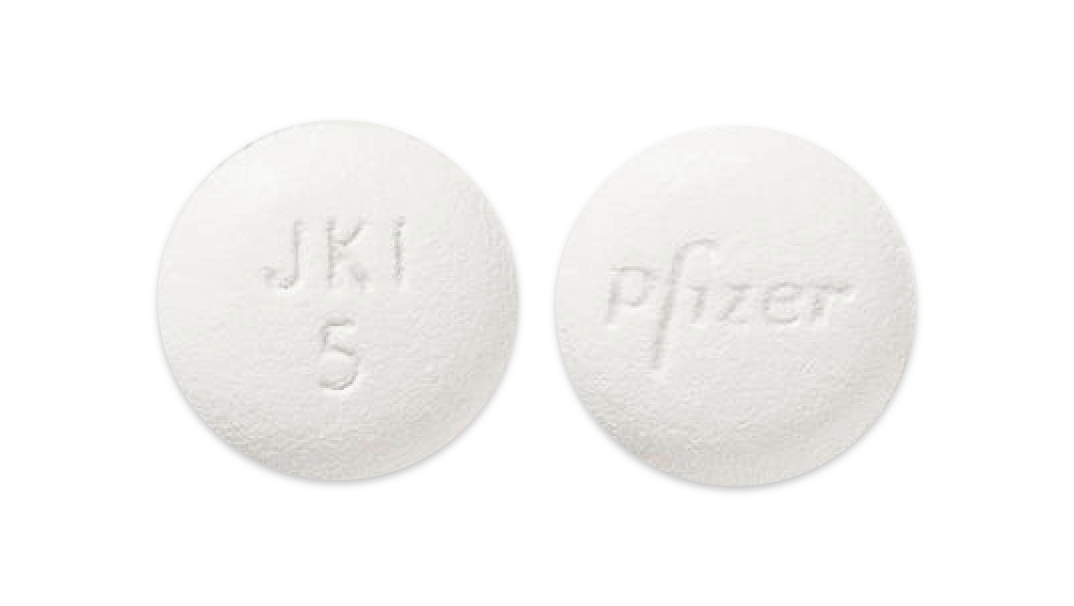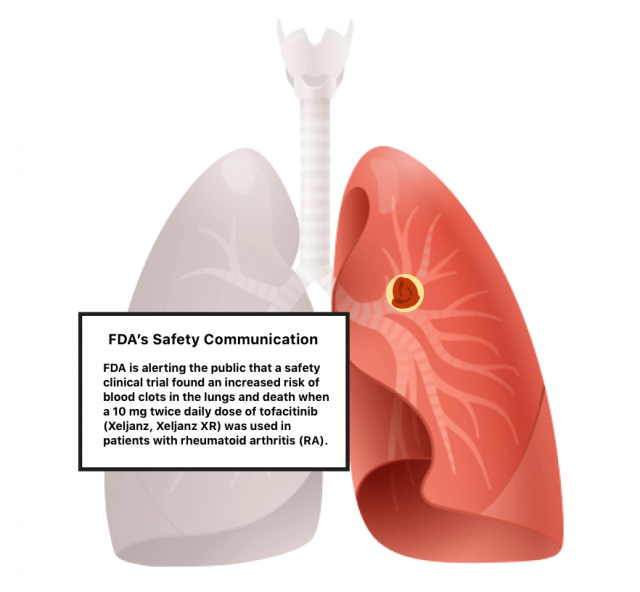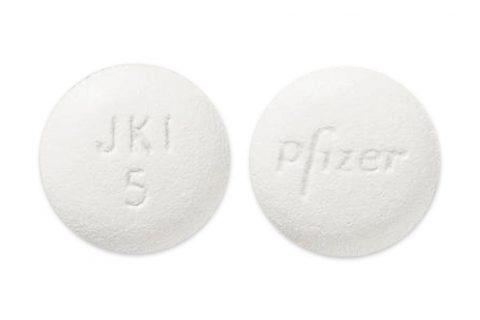Xeljanz Side Effects
Xeljanz side effects, such as headache and cold-like symptoms, are usually mild. However, this treatment for arthritis and ulcerative colitis carries several FDA warnings for serious infections, blood clots, heart problems, lymphomas, lung cancer and an increased risk of death.
Article Continues Below

Board-certified physicians medically review Drugwatch.com content to ensure its accuracy and quality.
Drugwatch.com partners with Physicians’ Review Network Inc. to enlist specialists. PRN is a nationally recognized leader in providing independent medical reviews.
Reviewer specialties include internal medicine, gastroenterology, oncology, orthopedic surgery and psychiatry.
Drugwatch.com has been empowering patients for more than a decade
Drugwatch.com has provided reliable, trusted information about medications, medical devices and general health since 2008. We’ve also connected thousands of people injured by drugs and medical devices with top-ranked national law firms to take action against negligent corporations.
Our team includes experienced medical writers, award-winning journalists, researchers and certified medical and legal experts. Drugwatch.com is HONCode (Health On the Net Foundation) certified. This means the high-quality information we provide comes from credible sources, such as peer-reviewed medical journals and expert interviews.
The information on Drugwatch.com has been medically and legally reviewed by more than 30 expert contributors, including doctors, pharmacists, lawyers, patient advocates and other health care professionals. Our writers are members of professional associations, including American Medical Writers Association, American Bar Association, The Alliance of Professional Health Advocates and International Society for Medical Publication Professionals.
About Drugwatch.com
- Assisting patients and their families since 2008.
- Helped more than 12,000 people find legal help.
- A+ rating from the Better Business Bureau.
- 5-star reviewed medical and legal information site.
Testimonials
"Drugwatch opened my eyes to the realities of big pharmacy. Having a family member with major depression and anxiety, I was looking for information on her medications. I found information that was very helpful, that her psychiatrist never told her."
- Common Side Effects
- Upper respiratory tract infection, cold-like symptoms, diarrhea, headache, rash and shingles
- Serious Side Effects
- Anemia, blood clots, cancer, cellulitis, gastrointestinal perforations, infection, jaundice, pneumonia and shingles
- Boxed Warning
- Packaging includes a boxed warning for serious infections, mortality, malignancy, major cardiovascular events and thrombosis
Most Recent Xeljanz Side Effects Information
According to the U.S. Food and Drug Administration’s Adverse Events Reporting System, pain, worsened condition, joint pain, fatigue and headache were among the most commonly reported Xeljanz side effects as of June 30, 2024.
| FDA Adverse Event Reports for Xeljanz Side Effects | |
|---|---|
| Total cases reported | 139,536 |
| Serious cases (including deaths) | 58,581 |
| Deaths | 4,876 |
Disclaimer: Reports sent to the FDA don’t necessarily mean the drug caused an adverse event. Consult a health care professional before stopping or changing medication.
The most recent prescribing information details common Xeljanz side effects. These include common cold, sinus infections, nasal congestion, sore throat, headache and acne. Patients also report gastrointestinal symptoms such as nausea, vomiting and diarrhea. However, side effects vary depending on the patient’s condition.
There are also risks of severe and life-threatening side effects from Xeljanz. The drug’s packaging includes a boxed warning for these serious adverse reactions: cancer, cardiovascular events, serious infections leading to hospitalization or death and thrombosis.
Common Xeljanz Side Effects
People taking Xeljanz in clinical trials reported upper respiratory infections, cold-like symptoms, headaches and diarrhea at higher rates than the control group. These occurred in at least 2% of study participants.
Studies involving individuals with psoriatic arthritis, ankylosing spondylitis and ulcerative colitis showed similar side effects affecting at least 5% of participants. Those with ulcerative colitis also reported cases of herpes zoster (shingles), increased levels of creatine phosphokinase (CPK) in their blood and rash.
CPK is an enzyme used for energy typically found in your skeletal muscles. An excess amount of CPK in the blood may indicate muscle damage.
- Cold-like symptoms
- Diarrhea
- High blood cholesterol levels
- Headache
- Rash
Many common side effects are manageable at home with over-the-counter treatments. These side effects include headaches, nausea and infections that cause cold-like symptoms. Often, a virus causes these symptoms.
Xeljanz can increase the risk of life-threatening infections. Therefore, you should monitor side effects carefully. Contact your doctor if you develop a high fever or your symptoms worsen or last longer than a few days.
Serious Xeljanz Side Effects
Xeljanz may cause serious, life-threatening side effects, including blood clots, lymphoma, lung cancer, heart attack and stroke. Patients who have heart disease, or at an increased risk of heart disease, should discuss this with their doctor before taking this medication.
There is also a risk of developing serious bacterial, fungal or viral infections when taking Xeljanz. Patients with latent tuberculosis should undergo treatment for that condition before starting Xeljanz.
- Increased risk of cancer
- Major adverse cardiovascular events
- Perforation of the stomach or intestines (most often as an interaction with nonsteroidal anti-inflammatory drugs, corticosteroids or methotrexate)
- Serious infections
- Severe allergic reaction
It’s also important to note that the rate of all-cause mortality (death) is higher among patients taking Xeljanz for rheumatoid arthritis compared to those taking other medications. This risk is greatest for patients over the age of 50 who have at least one risk factor for heart disease.
Xeljanz and Altered Blood Test Results
Xeljanz may decrease your red blood cell count, liver function and some types of immune-supporting white blood cells. Changes to these levels can affect your body’s ability to fight off infections.
Your doctor may test these levels before you begin the medication and then routinely while you’re on it. Some people may stop taking Xeljanz due to abnormal test results.
However, you generally shouldn’t discontinue a medication without first discussing it with your health care provider, as the benefits may outweigh the risks.
FDA Boxed Warnings for Xeljanz

The FDA requires a boxed warning on Xeljanz for five possible side effects: blood clots, cardiovascular events, cancer, serious infections and a higher rate of death for patients with rheumatoid arthritis.
A boxed warning is the most serious advisory the FDA assigns. It indicates the threat of serious health risk or death.
Blood Clots
Common types of blood clots associated with Zeljanz include pulmonary embolism, deep venous thrombosis and arterial thrombosis.
- Chest pain
- Difficulty breathing
- Discoloration in the arms or legs
- Leg pain
- Shortness of breath
- Swelling of the leg or arm
Notify your doctor immediately if you notice any symptoms of a blood clot. There are several Xeljanz lawsuits seeking compensation for patients who developed blood clots, heart problems or cancer after taking the drug.
Major Adverse Cardiovascular Events (MACE)
Patients taking Xeljanz may experience major adverse cardiovascular events, including heart attack or stroke. These symptoms include chest discomfort, shortness of breath and weakness on one side of your body. This is especially true for those over age 50 with at least one heart disease risk factor. Seek immediate medical attention if you experience signs of a major heart problem.
Increased Risk of Cancer
A 2022 study published in the New England Journal of Medicine linked Xeljanz to certain types of cancer. These include lymphoma, skin cancer and lung cancer.
While taking Xeljanz increases your likelihood of developing cancer, the risk is relatively low. The malignancy rate was 1.13% in patients during clinical trials.
Case Study: Cardiovascular and Cancer Risks of Xeljanz
A 2022 study in the New England Journal of Medicine examined the potential heart and cancer risks related to Xeljanz (tofacitinib), a drug commonly used to treat rheumatoid arthritis. The study focused on people aged 50 and above with at least one heart disease risk factor.
Study Design
The researchers split the participants into different groups. Some received tofacitinib, while others took a medication called a tumor necrosis factor (TNF) inhibitor. The study focused on two potential adverse events: major heart problems and cancer variations. However, one specific type of skin cancer was excluded from the study.
Findings
The results showed that people taking tofacitinib had a higher chance of experiencing major heart problems at a rate of 3.4%. They also had a higher risk of cancer at a rate of 4.2% compared to those taking TNF inhibitors.
The people taking TNF inhibitors had lower rates of 2.5% for heart problems and 2.9% for cancer. The study concluded that tofacitinib, the active ingredient in Xeljanz, is not as safe as the TNF inhibitors. Xeljanz showed a higher risk of these severe health issue
Serious Infection
Serious infections were one of the most common side effects reported in clinical trials and post-market reviews. Reports include bacterial, fungal and viral infections.
Doctors frequently use antibiotics to treat bacterial infections. Viruses, on the other hand, usually resolve on their own. However, in severe cases, doctors may prescribe antivirals to lessen the impact of life-threatening viral infections.
- Cellulitis
- Diverticulitis
- Herpes zoster (shingles)
- Pneumonia
- Tuberculosis
- Urinary tract infection
Patients with latent tuberculosis should not take Xeljanz without first undergoing tuberculosis treatment. If you have a history of tuberculosis, your doctor may perform routine testing for it while you take Xeljanz. People undergoing treatment for ulcerative colitis are at a higher risk than others for developing serious infections and shingles.
Editor Lindsay Donaldson contributed to this article.
Calling this number connects you with a Drugwatch.com representative. We will direct you to one of our trusted legal partners for a free case review.
Drugwatch.com's trusted legal partners support the organization's mission to keep people safe from dangerous drugs and medical devices. For more information, visit our partners page.



